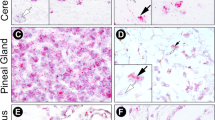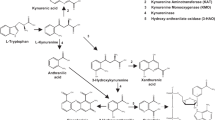Abstract
THERE is general agreement that 5-hydroxytryptamine (5HT) is formed from 5-hydroxytryptophan (5HTP) in the presence of 5-hydroxytryptophan decarboxylase (5HTPD). It is then oxidized to 5-hydroxyindolylacetic acid (5HIAH) with monoamine oxidase (MAO). A number of theories have been suggested to explain the decrease of brain 5HT in experimental phenylketonuria1–3. First, the excessive phenylalanine might inhibit the hydroxylation of tryptophan in the liver4 or brain5, and thus reduce the amount of 5HTP available. Second, this excess might inhibit the active transport of tryptophan6 or 5HTP7–9 across the blood brain barrier or brain cell membrane. Third, the excess of phenylalanine and its metabolites might inhibit the decarboxylation of 5HTP10,11.
This is a preview of subscription content, access via your institution
Access options
Subscribe to this journal
Receive 51 print issues and online access
$199.00 per year
only $3.90 per issue
Buy this article
- Purchase on Springer Link
- Instant access to full article PDF
Prices may be subject to local taxes which are calculated during checkout
Similar content being viewed by others
References
Yulwiler, A., and Louttit, R. T., Science, 134, 831 (1961).
Wang, H. L., Harwaklar, V. H., and Waisman, H. A., Arch. Biochem. and Biophys., 96, 181 (1962).
Hsia, D. Y. Y., Nishimura, K., and Brenchley, Y., Nature, 200, 578 (1963).
Freedland, R. A., Wadzinski, I. M., and Waisman, H. A., Biochem. Biophys. Res. Comm., 6, 227 (1961).
Gal, E. M., Poczik, M., and Marshall, F. D., Biochem. Biophys. Res. Comm., 12, 39 (1963).
Guroff, G., and Udenfriend, S., J. Biol. Chem., 237, 803 (1962).
McKean, C. M., Schanberg, S. M., and Giarman, N. J., Science, 137, 604 (1962).
Smith, S. E., Brit. J. Pharm., 20, 178 (1963).
Schanberg, S. M., J. Pharm. Exp. Therap., 139, 191 (1963).
Davison, A. N., and Sandler, M., Nature, 181, 186 (1958).
Huang, I., and Hsia, D. Y. Y., Proc. Soc. Exp. Biol. and Med., 112, 81 (1963).
Bogdanski, D. F., Weissbach, H., and Udenfriend, S., J. Neurochem., 1, 272 (1957).
Kuntzman, R., Shore, P. A., Bogdanski, D., and Brodie, B. B., J. Neurochem., 6, 226 (1961).
Wong, P., O'Flynn, M., and Inouye, T., Clin. Chem. (in the press).
Boggs, D. E., Rosenberg, R., and Waisman, H. A., Proc. Soc. Exp. Biol. and Med., 114, 356 (1963).
Freedland, R. A., Biochim. Biophys. Acta, 73, 71 (1963).
Author information
Authors and Affiliations
Rights and permissions
About this article
Cite this article
YI-YUNG HSIA, D., JUSTICE, P., BERMAN, J. et al. Brain Serotonin in Experimental Tyrosinosis. Nature 202, 495–496 (1964). https://doi.org/10.1038/202495a0
Issue Date:
DOI: https://doi.org/10.1038/202495a0
Comments
By submitting a comment you agree to abide by our Terms and Community Guidelines. If you find something abusive or that does not comply with our terms or guidelines please flag it as inappropriate.



